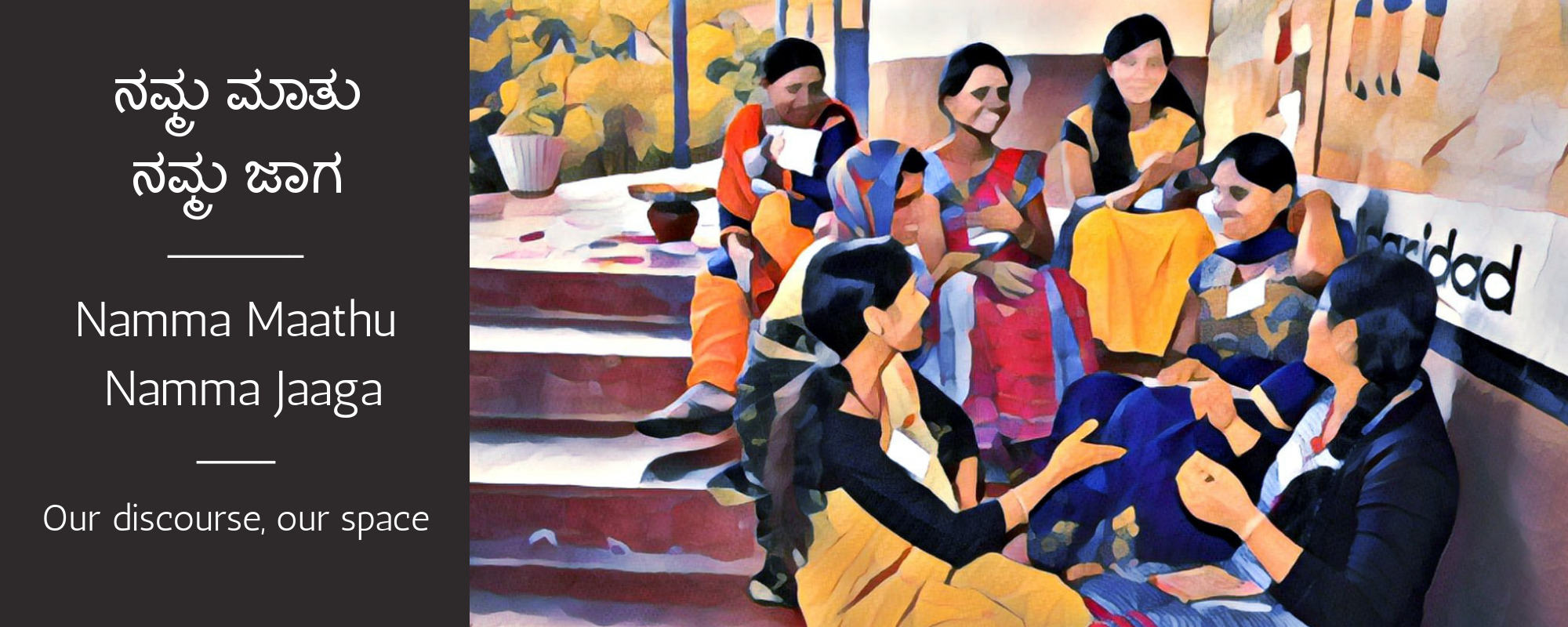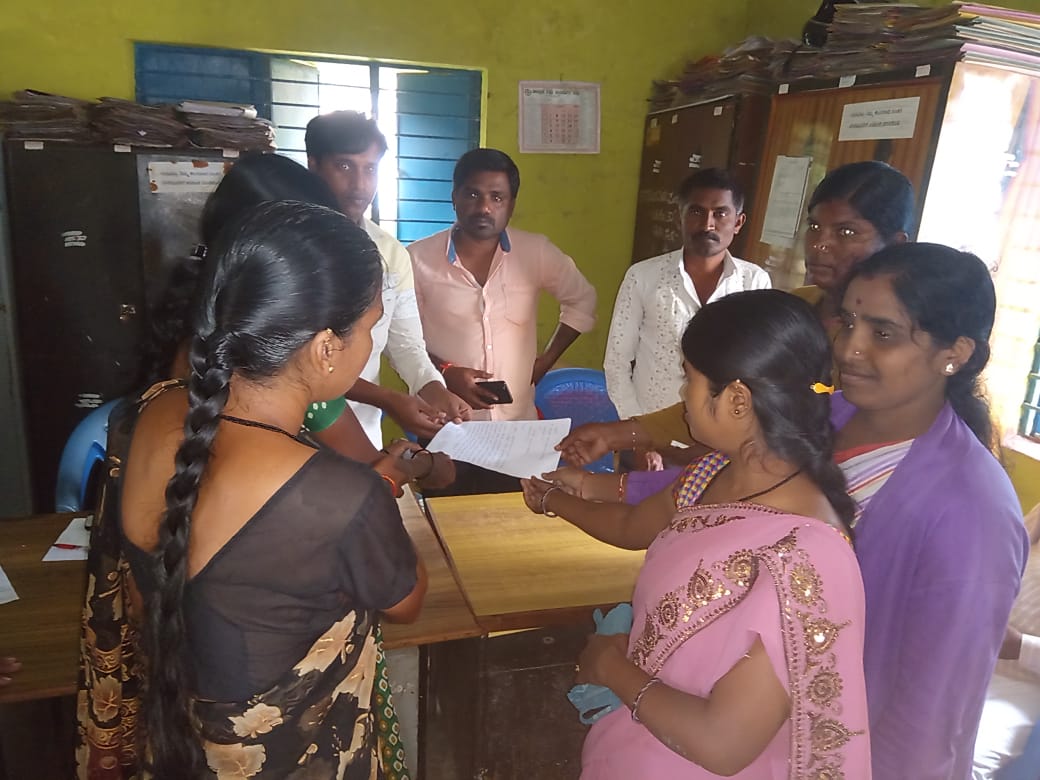
Campaign to introduce new bus routes in Kalihundy
Sarada Mahesh | November 2019
As a part of our regular interactions with the residents of Kalihundy, we noticed that parents of adolescent girls were reluctant to send their daughters to schools and colleges. They explained that the lack of adequate public transport created an environment that they felt was unsafe for the girls. These restrictions not only affect the girls’ right to movement, but also their right to education.

The tiny cluster of villages in Kalihundy located in HD Kote block of Mysore district brims with lit up faces of young adolescent girls, whose eyes shine bright at the thought of going to school and getting employed upon completing their education. The reality, however, is different.
Prakriye – Centre for Community Informatics and Development, is the field centre of the NGO, IT for Change. Located in the heart of Mysore city, the team at Prakriye works in 60 villages in HD Kote and Hunsur blocks of Mysore. Using the unique integration of information and communication technologies with the bottom up approach, the centre works towards the empowerment of women and adolescent girls.
As a part of our regular interactions with the residents of Kalihundy, we noticed that parents of adolescent girls were reluctant to send their daughters to schools and colleges. They explained that the lack of adequate public transport created an environment that they felt was unsafe for the girls. These restrictions not only affect the girls’ right to movement, but also their right to education.
Women leaders from the sanghas also expressed their dissatisfaction at the state of affairs in the village. “The area faces heavy rains and flooding. Recently, some of the girls were stuck in their campus after school hours because buses were not plying in the area due to heavy rains. We took it upon ourselves to bring together some of the men who had bikes, and asked them to go to the schools to pick up the girls. Almost 3 girls had to sit on one bike and the boys had to go back and forth until all of them came back.”
In addition to this, there are problems such as eve teasing and the presence of liquor shops near the bus stops, making it uncomfortable for the girls to walk in the area. They are also dependant on share autos or jeeps as alternatives to buses. However, these vehicles are often over crowded causing an invasion into the personal space of the woman. The roads are also badly constructed, and are often very narrow and isolated.
Perceived as a burden, these girls are forced to drop out of schools and are married off at a young age – more particularly when they are minors. Child marriages have become a common norm amongst these residents, who believe that the girl will be safer at the house of their husband rather than staying alone at home when her parents go out for work.
In order to get a better understanding of the problem, the team at Prakriye decided to conduct a survey with the adolescent girls in the villages. An important, distinguishing aspect of this data campaign was the use of the Open Data Kit application to administer the survey. This free and open source application allows for the offline collection of data through surveys which can then be analysed for further research.
A total of 16 girls in the age group of 13-17 years were interviewed from the villages of Kalihundy, Shankalli, Chakkuru, Kulya and Adally. They attend the high schools located in the villages of Homargally and Belathur, while the older girls attend colleges located in HD Kote and Mysore. The distance from the home of the respondents to their schools and colleges varied between 2-5 km (4 girls), more than 5 km (11 girls) and more than 60 km (1 girl). 10 girls said that if they do take the bus, they have to take it at 8.30 am, 5 of them have to take it at 9 am and for one, 7 am. The schools however, begin at 10 am and end at 4 pm. Students who have to take early buses are sometimes forced to wait outside the premises of the school till the gates opem. For the buses in the evening, 9 girls said that they have to take buses at 5 pm, 4 girls have to take buses at 5.30pm, two girls at 4.30 pm and 1 at 9pm.
Despite the availability of buses, however, the lack of frequency of these buses leads to their delay in reaching the destinations or in overcrowding. “Sometimes, we see buses tilting to one side because of the number of people inside!” laughed one of the sangha women. The risks of both accidents as well as the privacy of the girls in overcrowded spaces are very high.
They are thus forced to choose alternate modes of commute as they cannot afford to risk waiting for the buses. 5 girls said that they go to their school or college by walk, 4 girls take the auto or the bus, 5 go either by walk or by bus, one uses her cycle and one girl is dependant on a family member to drop her. If they do not have any mode of return, they have to stay at a relatives place close by and return home much later.
When compared to the risks involved in walking on lonely roads, or the load on the pocket when taking an auto or jeep, buses seem to be the preference – what with fares varying between Rs. 5 to Rs. 30, not only are they lighter on the pocket, but also if frequent, can serve as point to point modes of commuting.
Our interview with the teachers highlighted further problems. “The timings of the school have to be in line with the buses. Many a time, we cannot conduct or girls cannot attend the special classes that we conduct after school hours because they have to get the buses. They become distracted and restless in the evening because they have to run to get the buses. If they miss it, then they are pressured to look for alternate modes of commute to reach their homes.” Alternatively, many schools have special classes at 7 am in the morning, which students find difficult to attend due to lack of buses at that time.
Other consequences of the problem are the difficulties faced by the people during medical emergencies, particularly pregnant women. The nearest primary health centre is approximately 4-6 km from each of the villages. Due to the lack of buses in the area, the residents find it difficult to reach there on time.
The women leaders from the sangha decided to take the matters into their own hands. They approached the sakhi at the information centre set up in Kalihundy. Womaned by young women-sakhis, these information centres have been set up by the Prakriye team in 7 villages across HD Kote and Hunsur blocks of Mysore. These centres were set up with the objective of extending support to the residents of the villages. Each center caters to the need of 8-9 villages located within its vicinity. Through regular interaction and mentoring by the Prakriye team, the Sakhi’s execute their responsibilities of sharing information and consequently processing the claims and entitlements made by the villagers.
Together, they wrote a letter to the Panchayat Development Officers at K Belathur and Manuganahalli where they requested the authorities to ensure the availability and increase in the frequency of buses between 8-8.30 am and 4-5 pm. While officers acknowledged both the letter and the problem, he attributed one of the factors of the lack of frequency of the buses to the badly constructed roads. He advised the women to instead submit a petition to the road construction authorities to resolve the problem. “He said that he would try to ensure that the bus stops at Kalihundy. It came for one day and then stopped. Now it stops at our village at random times and is not very dependable. Currently, the closest stop at which the bus stops is in Homargally village, and that is about 4-5 km from where we stay. The students are forced to go there by foot everyday. The closest bus stop is located 1 km away from our village. It would be more convenient for the students if the bus stopped there.” one of the women explained. “We will fight till we get what we have asked for. We cannot continue to live with this inconvenience.”
They then approached the local MLA with their request, who gladly gave them an ear. Convinced by the arguments put forth by the women about the need to introduced bus routes, he spoke to the KSRTC officials. A circular was issued and buses were introduced in 6 new routes. The women’s joys new no bounds seeing their success. The incident had taught them about the larger impact that they can make when they work together rather than individually.